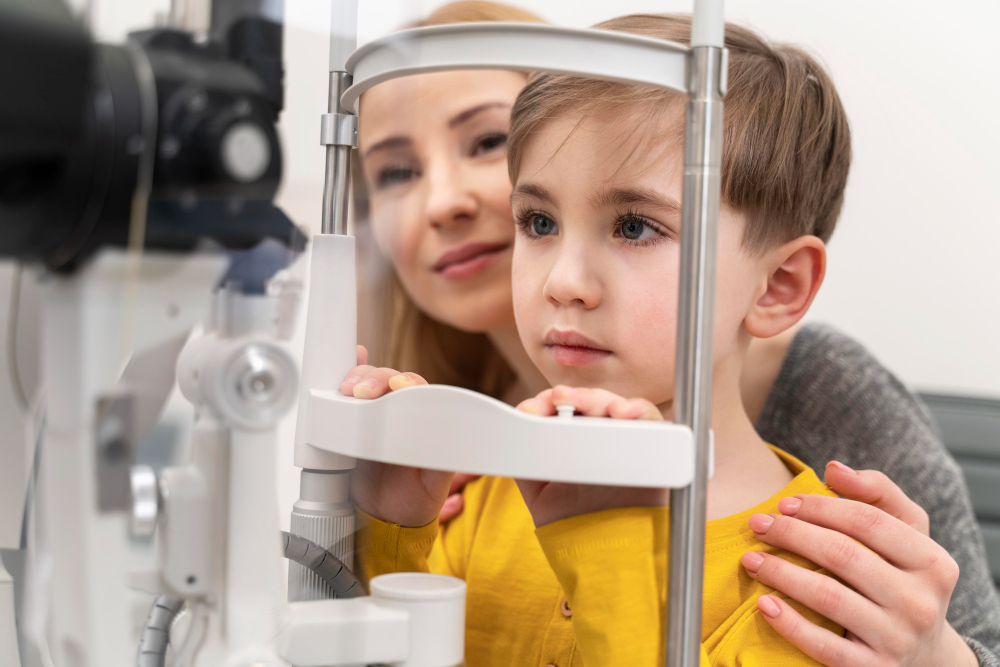
As a pediatric eye doctor, providing a comprehensive eye exam for children is critical to their overall health and development. Children’s eyes are constantly developing and can be affected by a variety of conditions that can go undetected without proper examination. It is important to have a thorough understanding of comprehensive eye exams for children. By knowing what to look for and how to properly evaluate a child’s vision and eye health, you can help catch vision problems early and ensure that children receive the care they need to maintain healthy eyesight.
The Importance of Comprehensive Eye Exams for Children
Comprehensive eye exams are critical for the early detection and treatment of eye conditions in children. Many eye problems can be asymptomatic or show vague symptoms that can be mistaken for other conditions. Without regular eye exams, vision problems can go undetected and lead to long-term vision problems or even blindness.
Children’s eye exams should start at around six months of age, and should be repeated at ages three and five, and annually thereafter. During the exam, eye doctors should check for visual acuity, eye alignment and eye movement, refractive errors, and overall eye health. It’s important to keep in mind that not all children will have the same eye exam results, and that the results of a comprehensive eye exam can be affected by age, developmental stage, and the child’s ability to communicate.
What to Look for During a Comprehensive Eye Exam for Children?
During a comprehensive eye exam for children, it is important to perform a variety of tests to evaluate their vision and eye health. These tests may include:
Visual Acuity Test: This test is used to measure how well a child can see at different distances. The child is typically asked to read letters or numbers on a chart from a specific distance, such as 20 feet.
Refraction Test: This test helps determine if a child needs glasses or contact lenses to correct their vision. By placing different lenses in front of the child’s eyes, the doctor can determine the best prescription to correct any vision problems.
Eye Muscle Movement Test: This test evaluates how well a child’s eyes move and work together. The doctor will observe the child’s eye movements and assess their ability to focus on objects at different distances.
Pupil Dilation: This test involves putting drops in the child’s eyes to help the eye doctor see the back of the eye more clearly. This can help detect any signs of eye diseases or disorders.
Screening for Eye Diseases or Disorders: During the exam, the doctor may use specialized instruments to check for any signs of eye diseases or disorders, such as amblyopia, strabismus, or nearsightedness.
Communication with Parents
In addition to performing a thorough eye exam, it is important to communicate with parents about their child’s eye health. This includes discussing any findings from the exam and explaining any necessary treatment or further testing that may be needed. It is also important to provide parents with information on how to help their child maintain healthy eyesight, such as encouraging them to take regular breaks from digital devices and protecting their eyes from harmful UV rays.
The Importance of Regular Eye Exams
Regular comprehensive eye exams are essential for children to maintain healthy eyesight and catch any vision problems early. By scheduling regular exams, eye doctors can help prevent more serious health issues from developing and ensure that children receive the care they need to maintain good vision. By performing a variety of tests to evaluate vision and eye health and communicating with parents about their child’s eye health, eye doctors can help catch vision problems early and ensure that children receive the care they need to maintain healthy eyesight.
Comprehensive eye exams for children are a critical part of maintaining their overall health and development. Advanced eye doctors should be well-versed in the various components of a comprehensive eye exam, and should know how to identify and treat common vision problems in children. By staying up-to-date with the latest research and guidelines, eye doctors can provide the best possible care for their young patients.
References:
- “Comprehensive Eye Exams for Children” by American Optometric Association. https://www.aoa.org/patients-and-public/good-vision-throughout-life/childrens-vision/comprehensive-eye-and-vision-examination-for-children
- “Eye Exams for Children: What to Expect” by Cleveland Clinic. https://health.clevelandclinic.org/eye-exams-for-children-what-to-expect/
- “Children’s Eye Exams: What to Expect” by WebMD. https://www.webmd.com/eye-health/childrens-eye-exams-what-to-expect
- “Why Regular Eye Exams are Important for Children” by American Academy of Ophthalmology. https://www.aao.org/eye-health/tips-prevention/children-eye-exams


